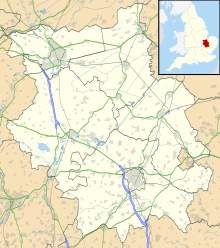Bedford Purlieus National Nature Reserve
| Site of Special Scientific Interest | |
 |
|
| Area of Search | Cambridgeshire |
|---|---|
| Grid reference | TL042995 |
| Coordinates | 52°35′00″N 0°27′33″W / 52.5833°N 0.4591°WCoordinates: 52°35′00″N 0°27′33″W / 52.5833°N 0.4591°W |
| Interest | Biological |
| Area | 211 hectares (520 acres) |
| Notification | 1969 |
| Natural England website | |
Bedford Purlieus is a 211-hectare (520-acre) ancient woodland in Cambridgeshire, in the United Kingdom. It is a national nature reserve and Site of Special Scientific Interest owned and managed by the Forestry Commission. In Thornhaugh civil parish, 10 km (6.2 mi) south of Stamford and 14 km (8.7 mi) west of Peterborough, the wood is within the Peterborough unitary authority area of Cambridgeshire, and borders Northamptonshire. In Roman times it was an iron smelting centre, during the medieval period it was in the Royal Forest of Rockingham, and later it became part of the estates of the Duke of Bedford. Bedford Purlieus appears to have been continuously wooded at least from Roman times, and probably since the ice receded. The woodland may have the richest range of vascular plants of any English lowland wood. It acquired particular significance in the 1970s as an early subject for the historical approach to ecology and woodland management.
Bedford Purlieus was declared a national nature reserve (NNR) in 2000. Most of England's 224 NNRs are managed by Natural England, but 88 are wholly or partly managed by other approved bodies. Bedford Purlieus is managed by the Forestry Commission, and is open to the public during daylight hours. It is notable for having a wider variety of herbaceous woodland plants than almost any other English woodland. The 211 hectares (520 acres) of ancient woodland was declared a Site of Special Scientific Interest in 1969, and it is a Nature Conservation Review site, Grade I. The abundance and variety of the woodland flora and fauna is outstanding. The range of woodland flowers are especially notable. There were 462 species of vascular plants listed as present in the woods in 1975, and the whole range of flora associated with ancient woodland is exceptionally rich. A principal reason for this is the variety of soil types, resulting from a geology that ranges from highly calcareous limestone and tufa through to highly acidic sands and silts. The variety of coppice woodland types, the management history, the wide grassland rides, and even the periodic disturbances caused by coppicing, felling and other interventions such as the wartime installations have all added habitats that maintain the diversity of species within the woods.
...
Wikipedia

